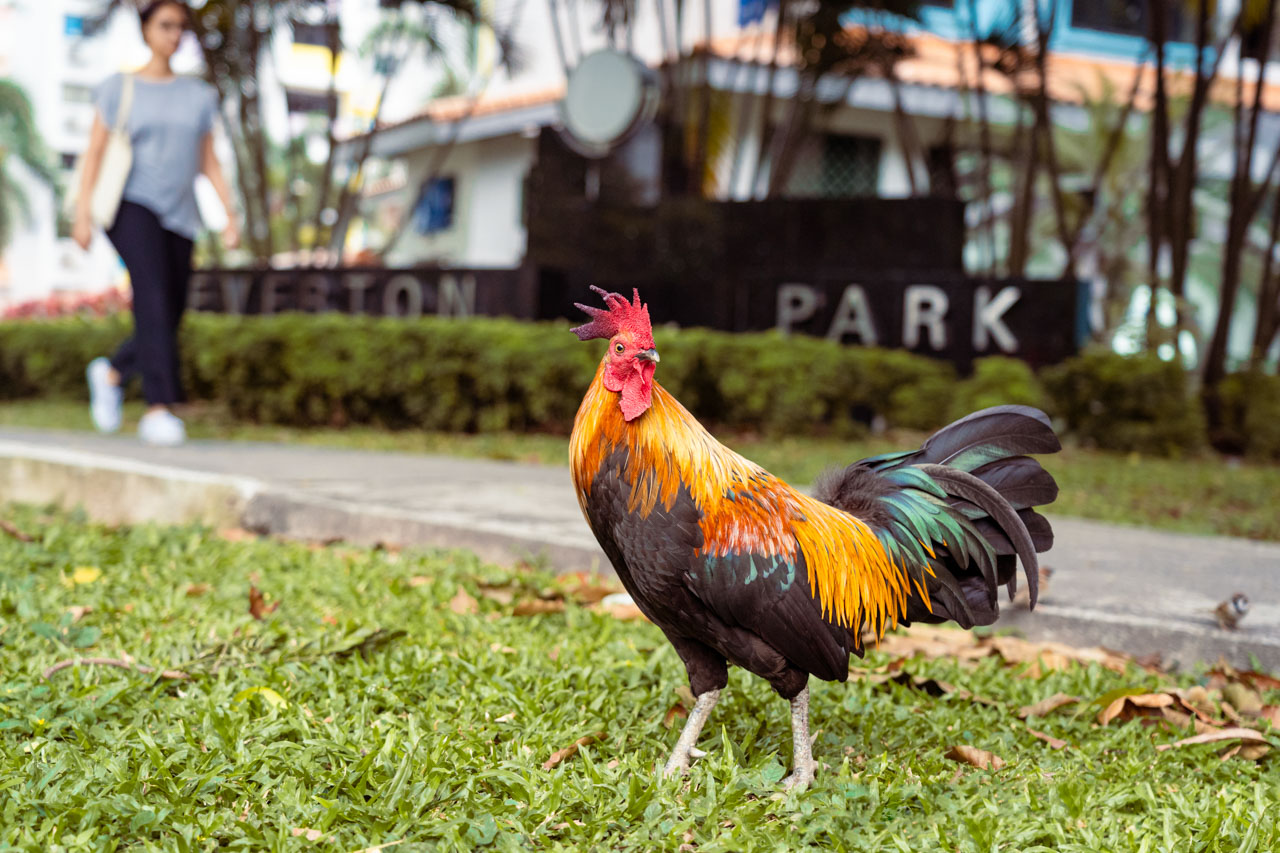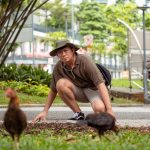All Images are by Stephanie Lee unless otherwise stated
If Sir David Frederick Attenborough’s series of nature documentaries have taught us anything, it is that life thrives on Earth’s most unforgiving environments—from the slopes of Mount Everest to the depths of the Mariana Trench.
Yet another ‘unforgiving’ environment lies near the equator: Singapore’s urban jungle. It’s hot and humid all year round and jam-packed with sweaty humans, damp on the skin, their eyes glazed over, teeth tightly gritted, as if tense tolerance (sans aircon) would make the weather more bearable.
ADVERTISEMENT
Still, despite the city’s punishing nature, wildlife continues to prosper in the most unlikely of places. Like Everton Park, one of Singapore’s oldest housing estates, a 5 minutes’ walk away from the hallowed Police Cantonment Complex.
Here,
chickensjunglefowls roam freely and undisturbed, a strange sight for residents more accustomed to, you know, angry licence-plate-ripping aunties with road rage issues.
But I digress.
Along the void decks’ narrow corridors and across stretches of well-mowed grass, Red Junglefowls (scientific name: Gallus gallus) strut proudly by. Avian neighbourhood watch is in session.
There is an unusually large number of them here—so common that residents think of them as a quirk as opposed to an intrusion.
You should know that a junglefowl’s life is not all about roosting and breeding. It needs its daily sixty minutes of workout to keep lean and healthy, if only to fend off desperate humans craving for chicken in the wake of a poultry export ban.
As if to prove my point, a hen appears in my peripheral vision, seemingly on its way to the estate’s fitness corner. I made a mental note to check back for a potentially hilarious photo op.
Alas, it’s simply hobbling its way towards a flock further ahead.
Maybe this one’s Beatrice.
“My neighbour had this empty flower pot, and a hen flew up to our floor and laid about five or six eggs there,” Jeanna, an Everton Park resident, recalls. “We called her Beatrice.”
Jeanna tells me that every night, like clockwork, Beatrice would come back to her pot to sit on the eggs. “I look forward to seeing Beatrice and her eggs every morning on my way to work, but sadly, they left after two weeks.”
Fine Feathered Friends
Most days, in the wee hours of the morning and the late evenings, sounds of the junglefowl cut through the estate. It sounds very much like its direct descendant, the chicken, except its crows are abruptly cut off at the end, like a stifling cough at the peak of a singer’s final belt.
ADVERTISEMENT
It’s more abrupt, less dramatic. But just as cacophonous, especially when everyone’s sound asleep.
Still, residents and shop owners insist that they don’t mind the noise; it’s very much an acquired tolerance.
“One of them will make some noise, and another will reply. I don’t mind it. I’ll wear my earplugs to sleep. I don’t find them a nuisance,” declares Jeanna.
Evidently, the people of the estate have achieved an easy-going, almost casual equilibrium of coexistence with the junglefowl, now a permanent installation of Everton Park.
Mr Goh, a teacher at a tuition centre situated at a void deck in Everton Park, perfectly sums it up in a quintessentially Singaporean mantra: “We don’t disturb them. They don’t disturb us”.
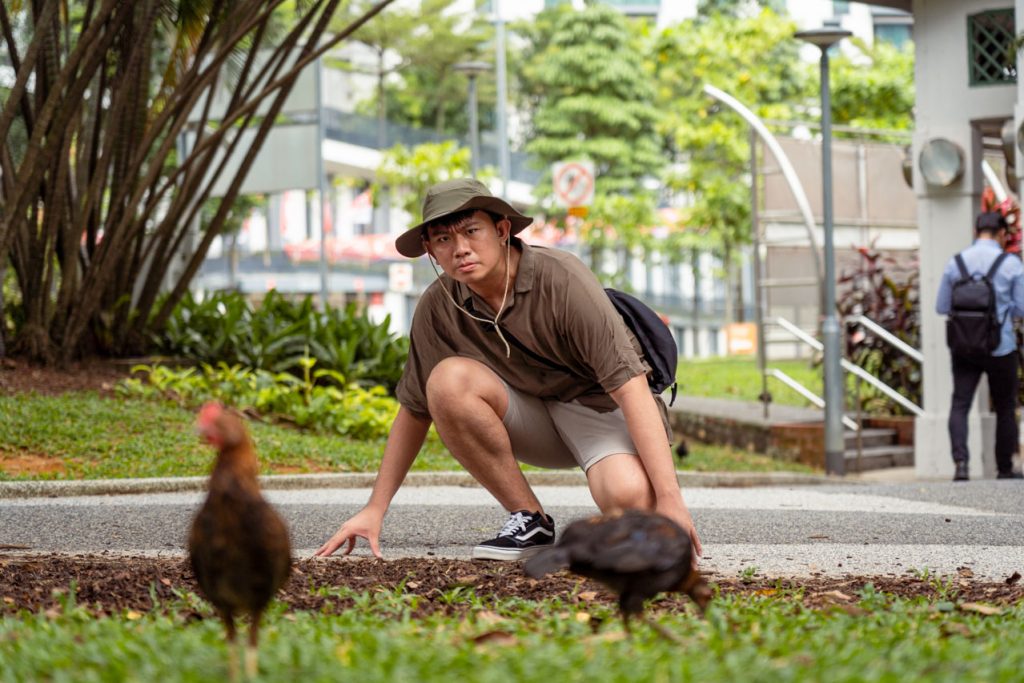
A Junglefowl By Any Other Name
While they seem similar at first glance, there are subtle differences between the junglefowl and the domestic chicken.
Junglefowls are considerably bigger than their descendants, with a distinctive white patch on its tail.
Strangely, junglefowl like Beatrice—ones that aren’t afraid to cosy up in the warm embrace of a human’s empty flower pot—are not like other junglefowl. Red junglefowls are much shyer than we think, an evolved defence mechanism against natural predators.
“Singapore’s red junglefowl don’t run away from us,” says Melody Wu, junglefowl whisperer and a research assistant at NUS’ Avian Evolution Lab.
“When you approach them in Thailand forests, they’re gone the moment they see you. Here, the red junglefowl has gotten used to humans.”
On a spacious grass patch just in front of the estate, a cautious hen strutted towards a child, his arms outstretched, an apparent attempt to pet a feathered friend. It shows no fear (the junglefowl, not the child), a testament to how acclimated they are to humans.
“About 90 percent of residents we spoke to are happy and supportive that the junglefowls are in their estate,” Joe Kam, a local wildlife rescue specialist shares.
Something about free-roaming red junglefowls has a profound effect on us. Perhaps, these chicken lookalikes remind us of a time gone by, of that elusive kampong spirit that we haven’t quite fully recaptured.

The Flight of the Junglefowl
“During the Last Glacial Maximum, when sea levels were much lower, we were connected from Peninsular Malaysia all the way to Sumatra,” Melody explains when I asked how these junglefowls came to be at Everton Park.
ADVERTISEMENT
“This means you can expect to find red junglefowls throughout the region. They’re native to Singapore.”
During the roaring 90s, rapid development and clearing of land to make way for homes and offices displaced the junglefowls out of their natural habitat. Its population couldn’t keep up with the pace, and our feathered friends were considered extinct from Singapore approximately thirty to forty years ago.
Driven underground by modern leanings, their return to the mainland is perplexing. Could this be the work of a particularly committed avian enthusiast smuggling junglefowls across our borders?
“Actually, no. (Red junglefowls) flew down from Johor to Pulau Ubin. From Ubin, they flew back onto mainland Singapore,” Melody answers matter-of-factly. “The challenge of flight across the Johor Straits can be surmounted by their flight abilities.”
Unfortunately, the story of its return is not all sunshine and rainbows. Singapore’s free-roaming red junglefowl population faces yet another threat.
People are releasing domestic chickens onto the streets of Singapore.
“When junglefowls interbreed with domestic chickens, domestic genes may swamp into the red junglefowl. It can homogenise the wild red junglefowl population to a more domestic looking profile.”
Melody continues, “I have heard of ornamental chicken pet groups or people who cannot keep their pet chickens anymore, they decide they can’t keep them anymore and release them into the wild.”
In other parts of Singapore like Sin Ming and Rifle Range, wild, majestic red junglefowl are, in fact, starting to look more like its domestic descendant, the chicken.
Melody points out the local scientific community’s efforts to conserve the genome of wild-type junglefowl here. Coexistence with native wildlife is a delicate balance—and something that we’ve not quite achieved yet in Singapore.
“We want to leave wild animals as wild. We don’t want to alter their behaviour,” remarks Joe. Or, for that matter, their wild-type genome.
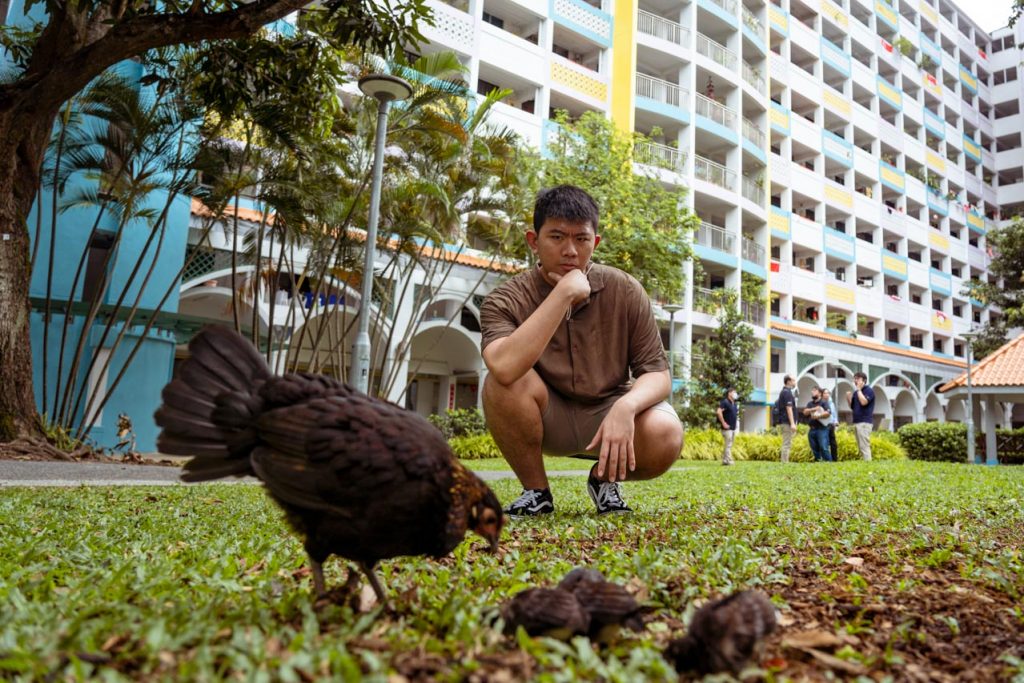
A Future of Coexistence
The people of Everton Park have hit on what could be the golden rule to a future of coexistence with all of the island’s native wildlife: just let them be.
For this story, I returned to the estate many more times than necessary—under the guise of investigation, of course.
But really, I just needed a breather from the office. Oh, to be a carefree junglefowl. (Editor’s note: Hykel has given us due feedback on his workload, and we’re looking into it, so stop sending us emails. Thanks.)
On each occasion, I trailed behind different flocks of junglefowl, careful not to interrupt their daily patrols—just a way to clear my conscience of skiving. The expeditions always ended the same way: people-watching.
As I sat and observed from afar, residents, young and old admired the birds from a respectable distance; some ignored them completely. The only attention these junglefowls get is when they crow.
In fact, a shop owner who wishes to remain anonymous, not too far away from where Mr Goh worked, was puzzled that I was even writing this story at all.
“They’ve been here longer than I have. I don’t really think or care about them,” he answered with furrowed brows, puzzled that someone would dedicate a whole story to “chickens”.
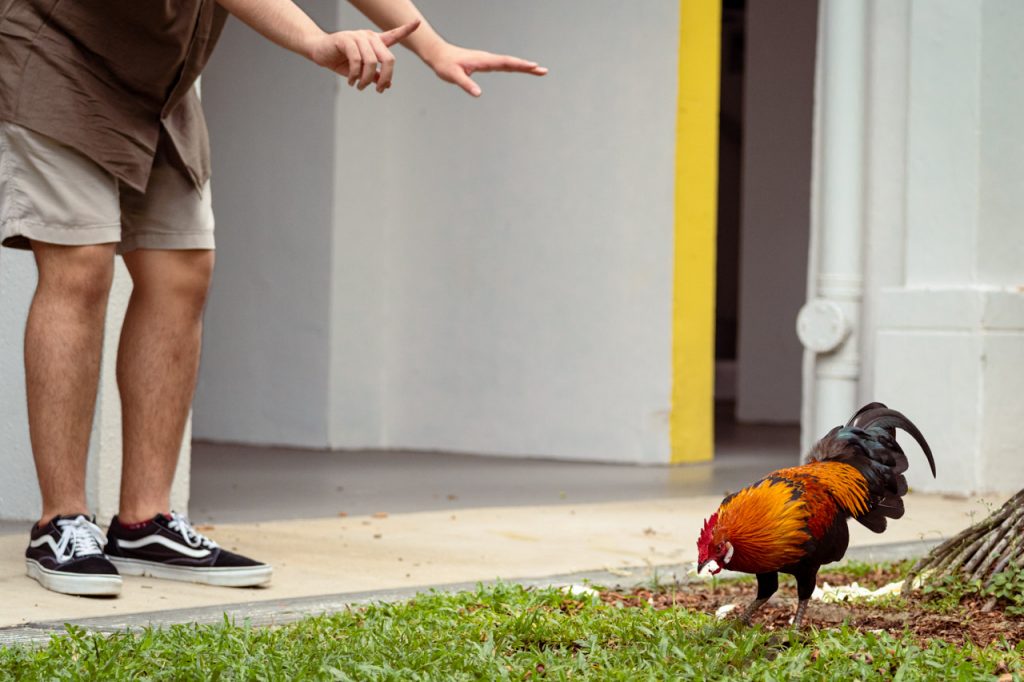
A Love Letter to Our Native Wildlife
But really, here’s my underlying motivation for this story: More love needs to go out to the rest of our native wildlife, especially those we shun because they don’t fit the mainstream perception.
“When you talk about wildlife in Singapore, immediately people will think lions, elephants—anything they can find in a zoo. What about wild boars? Snakes? Monitor lizards?” Joe decries.
Despite its land area, Singapore remains rich in biodiversity despite a considerable threat from an ongoing extinction crisis. One that’s unseen, unheard, and under-discussed.
If we’re not careful, the red junglefowl, along with other native wildlife, might once again follow in the footsteps—or in this case, tracks—of their forefathers: a life of extinction.
“This is their home as well,” Melody expounds.
“Conservation is not about capturing wildlife and keeping them in cages indefinitely. The end goal is to reintroduce them back to their environments. That’s the whole point.”
It’s easy for animals like lions and tigers to impress with their air of regalness, dominance, and power. Compare this, however, with conversations about macaques or wild boars, which often carry an undercurrent of disdain. When most people speak of them, they’re more akin to mammalian pests than native wildlife.
But these animals can mean so much more to us than an unfortunate symptom of having to live on this tropical island. Perhaps they, too, could be symbolic of values we want to cherish—rootedness, a sense of home, and diversity.
Melody’s final thoughts encapsulate the attitude we should all have when it comes to our native wildlife. “Coexist mutually. Together,” she intones. “If you want to be a garden city, there will be wildlife. We will have to coexist one way or another.”
I stood at the arched gate entrance of Everton Park at the close of my so-called research, watching the skies of Everton Park turn a deep hue of orange. It’s a pretty sight, made more poetic as junglefowls roost on branches, fluffing their feathers and snuggling down for the night.
No more excuses to give my bosses to come here and look at birds, I thought to myself. Also, I still haven’t found Beatrice. Damn.
And that’s perfectly fine with me. I’ll return to Everton Park; there’s so much more to explore and plenty more chances to find this elusive hen—just not on company time.

